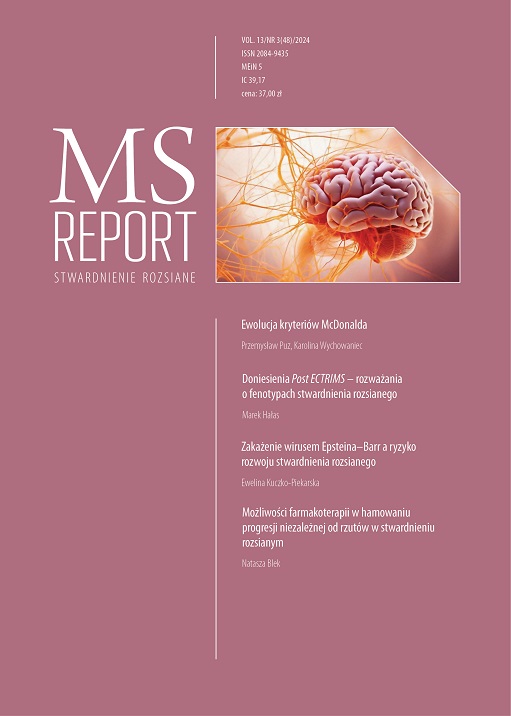Ewolucja kryteriów McDonalda Artykuł przeglądowy
##plugins.themes.bootstrap3.article.main##
Abstrakt
Kryteria McDonalda wykorzystywane w diagnozowaniu stwardnienia rozsianego zmieniały się w ostatnim ćwierćwieczu. Po raz pierwszy zostały ogłoszone w 2001 r., a później co kilka lat dokonywano ich rewizji, pozwalających zwiększyć czułość i swoistość kryteriów oraz przyspieszyć rozpoznanie choroby (co istotnie wpływa na wcześniejsze rozpoczęcie odpowiednich terapii modyfikujących przebieg choroby). Ostatnia modyfikacja została przedstawiona na tegorocznym zjeździe ECTRIMS we wrześniu 2024 r. Podstawowe założenia zmian kryteriów McDonalda obejmują: uznanie rzutów w wywiadzie za równoważne klinicznie izolowanemu zespołowi, uznanie zespołu izolowanego radiologicznie za specyficzną sytuację stwardnienia rozsianego, dołączenie nerwu wzrokowego jako piątej lokalizacji topograficznej zmian typowych dla stwardnienia rozsianego oraz rezygnację z kryterium rozsiania w czasie jako warunku niezbędnego do rozpoznania choroby. W zakresie diagnostyki zarówno laboratoryjnej, jak i neuroobrazowej zaproponowano nowe narzędzia diagnostyczne: objaw żyły centralnej i zmiany o paramagnetycznym wzmocnieniu brzeżnym w badaniu metodą rezonansu magnetycznego oraz obecność łańcuchów lekkich κ w płynie mózgowo-rdzeniowym. Zastosowanie nowo proponowanych kryteriów rozpoznania stwardnienia rozsianego pozwala na łatwiejsze zdiagnozowanie choroby u wybranych chorych i rozpoznanie jej u pacjentów, u których na podstawie wcześniejszych kryteriów nie można było tego zrobić.
##plugins.themes.bootstrap3.article.details##
Copyright © by Medical Education. All rights reserved.
Bibliografia
2. Kuhlmann T, Moccia M, Coetzee T et al. International Advisory Committee on Clinical Trials in Multiple Sclerosis. Multiple sclerosis progression: time for a new mechanism-driven framework. Lancet Neurol. 2023; 22(1): 78-88. http://doi.org/10.1016/S1474-4422(22)00289-7.
3. Thompson AJ, Banwell BL, Barkhof F et al. Diagnosis of multiple sclerosis: 2017 revisions of the McDonald criteria. Lancet Neurol. 2018; 17(2): 162-73. http://doi.org/10.1016/S1474.
4. Miller DH, Chard DT, Ciccarelli O. Clinically isolated syndromes. Lancet Neurol. 2012; 11: 157-69. http://doi.org/10.1016/S1474-4422(11)70274-5.
5. Sorensen PS, Sellebjerg F, Hartung HP et al. The apparently milder course of multiple sclerosis: changes in the diagnostic criteria, therapy and natural history. Brain. 2020; 143(9): 2637-52. http://doi.org/10.1093/brain/awaa145.
6. Traboulsee AL, Li DK. The role of MRI in the diagnosis of multiple sclerosis. Adv Neurol. 2006; 98: 125-46.
7. Filippi M, Rocca MA, Calabrese M et al. Intracortical lesions: relevance for new MRI diagnostic criteria for multiple sclerosis. Neurology. 2010; 75(22): 1988-94. http://doi.org/10.1212/WNL.0b013e3181ff96f6.
8. McDonald WI, Compston A, Edan G et al. Recommended diagnostic criteria for multiple sclerosis: guidelines from the International Panel on the diagnosis of multiple sclerosis. Ann Neurol. 2001; 50(1): 121-7. http://doi.org/10.1002/ana.1032.
9. Poser CM, Paty DW, Scheinberg L et al. New diagnostic criteria for multiple sclerosis: guidelines for research protocols. Ann Neurol. 1983; 13(3): 227-31. http://doi.org/10.1002/ana.410130302.
10. Dalton CM, Brex PA, Miszkiel KA et al. Application of the new McDonald criteria to patients with clinically isolated syndromes suggestive of multiple sclerosis. Ann Neurol. 2002; 52(1): 47-53. http://doi.org/10.1002/ana.10240.
11. Milo R, Miller A. Revised diagnostic criteria of multiple sclerosis. Autoimmun Rev. 2014; 13(4-5): 518-24. http://doi.org/10.1016/j.autrev.2014.01.012.
12. Polman CH, Reingold SC, Edan G et al. Diagnostic criteria for multiple sclerosis: 2005 revisions to the „McDonald Criteria”. Ann Neurol. 2005; 58(6): 840-6. http://doi.org/10.1002/ana.20703.
13. Swanton JK, Fernando K, Dalton CM et al. Modification of MRI criteria for multiple sclerosis in patients with clinically isolated syndromes. J Neurol Neurosurg Psychiatry. 2006; 77(7): 830-3. http://doi.org/10.1136/jnnp.2005.073247.
14. Polman CH, Reingold SC, Banwell B et al. Diagnostic criteria for multiple sclerosis: 2010 revisions to the McDonald criteria. Ann Neurol. 2011; 69(2): 292-302. http://doi.org/10.1002/ana.22366.
15. Deisenhammer F, Zetterberg H, Fitzner B et al. The Cerebrospinal Fluid in Multiple Sclerosis. Front Immunol. 2019; 10: 726. http://doi.org/10.3389/fimmu.2019.00726.
16. Kennedy PGE, George W, Yu X. The elusive nature of the oligoclonal bands in multiple sclerosis. J Neurol. 2024; 271(1): 116-24. http://doi.org/10.1007/s00415-023-12081-7.
17. Schwenkenbecher P, Wurster U, Konen FF et al. Impact of the McDonald Criteria 2017 on Early Diagnosis of Relapsing-Remitting Multiple Sclerosis. Front Neurol. 2019; 10: 188. http://doi.org/10.3389/fneur.2019.00188.
18. Montalban X. Revised McDonald criteria 2023. ECTRIMS 2024, Copenhagen 18-20 Sep 2024.
19. Wattjes MP, Ciccarelli O, Reich DS et al. Magnetic Resonance Imaging in Multiple Sclerosis study group; Consortium of Multiple Sclerosis Centres; North American Imaging in Multiple Sclerosis Cooperative MRI guidelines working group. 2021 MAGNIMS-CMSC-NAIMS consensus recommendations on the use of MRI in patients with multiple sclerosis. Lancet Neurol. 2021; 20(8): 653-70. http://doi.org/10.1016/S1474-4422(21)00095-8.
20. Clarke MA, Samaraweera AP, Falah Y et al. Single Test to ARrive at Multiple Sclerosis (STAR-MS) diagnosis: A prospective pilot study assessing the accuracy of the central vein sign in predicting multiple sclerosis in cases of diagnostic uncertainty. Mult Scler. 2020; 26(4): 433-41. http://doi.org/10.1177/1352458519882282.
21. Ontaneda D, Sati P, Raza P et al. North American Imaging in MS Cooperative. Central vein sign: A diagnostic biomarker in multiple sclerosis (CAVS-MS) study protocol for a prospective multicenter trial. Neuroimage Clin. 2021; 32: 102834. http://doi.org/10.1016/j.nicl.2021.102834.
22. Meaton I, Altokhis A, Allen CM et al. Paramagnetic rims are a promising diagnostic imaging biomarker in multiple sclerosis. Mult Scler. 2022; 28(14): 2212-20. http://doi.org/10.1177/13524585221118677.
23. Hegen H, Walde J, Berek K et al. Cerebrospinal fluid kappa free light chains for the diagnosis of multiple sclerosis: A systematic review and meta-analysis. Mult Scler. 2023; 29(2): 169-81. http://doi.org/10.1177/13524585221134213.
24. Vidal-Jordana A, Sastre-Garriga J, Tintoré M et al. Optic nerve topography in multiple sclerosis diagnostic criteria: Existing knowledge and future directions. Mult Scler. 2024; 30(2): 139-49. http://doi.org/10.1177/13524585231225848.
25. Okuda DT, Mowry EM, Beheshtian A et al. Incidental MRI anomalies suggestive of multiple sclerosis: the radiologically isolated syndrome. Neurology. 2009; 72(9)800-5. http://doi.org/10.1212/01.wnl.0000335764.14513.1a.
26. Landes-Chateau C, Levraut M, Okuda DT et al; on behalf RISConsortium. The diagnostic value of the central vein sign in radiologically isolated syndrome. Ann Clin Transl Neurol. 2024; 11(3): 662-72. http://doi.org/10.1002/acn3.51986.
27. Lebrun-Frénay C, Okuda DT, Siva A et al. The radiologically isolated syndrome: revised diagnostic criteria. Brain. 2023; 146(8): 3431-43. http://doi.org/10.1093/brain/awad073.

